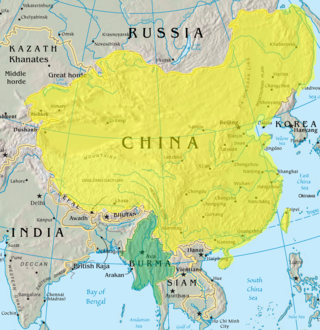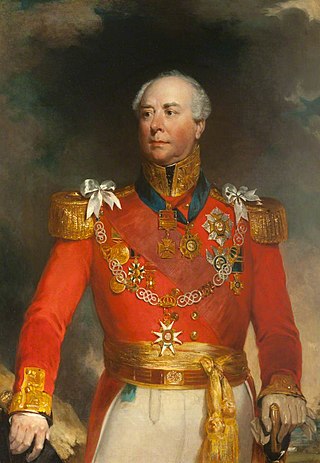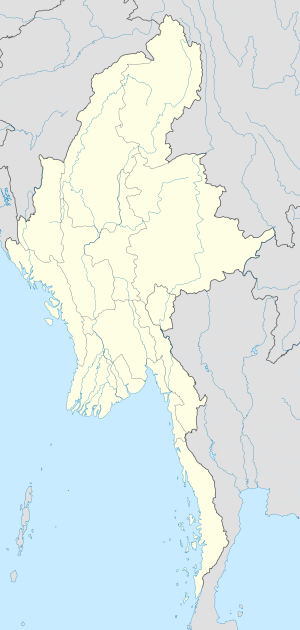The battle of Prome was a land-based battle between the Kingdom of Burma and the British Empire that took place near the city of Prome, modern day Pyay, in 1825 as part of the First Anglo-Burmese War. It was the last-ditch effort by the Burmese to drive out the British from Lower Burma. The poorly equipped Burmese army despite the advantage in numbers suffered a defeat. The British army's subsequent march toward north threatened Ava, which led to peace negotiation by the Kingdom of Burma.
Following the defeat at Danubyu and the death of General Maha Bandula, King Bagyidaw ordered the general Maha Ne Myo to capture Prome with an army. With superiority in number, the Burmese army divided into three divisions and positioned themselves around Prome in Simbaik, Napadi hills, and the western shore of Irrawaddy river. The Burmese army harassed the British position in outlying regions around Prome by leading small raids but did not commit to an attack on Prome itself.
The British army, led by Gen. Archibald Campbell, composed of several regiments of Royal Foot infantry and Madras Native infantry and artillery. On 1 December 1825, General Campbell initiated an attack on the left division led by Maha Ne Myo, while distracting the centre division with a cannon barrage. The left division was stormed with a bayonet charge led by Lt. General Willoughby Cotton and a follow-up attack by General Campbell caused a complete rout of the left division of the Burmese army. The British army attacked the center division on the Napadi hills the following day, and due to the bravery of the Native infantry, drove the Burmese troops from the hills. An attack on the right division, situated on the western shore of Irrawaddy river, caused a general retreat of the Burmese army.
Background
After defeating the Burmese army and their commander-in-chief Maha Bandula at Danubyu in April 1825, the British consolidated their gains in Lower Burma (up to Prome), Arakan and Tenasserim coast as well as in Assam and Manipur. Initial peace negotiations were commenced in September 1825 at Ngagyaungbinzeik, 20 miles north of Prome. [2] The British demanded that the Burmese recognize "the independence of Manipur" and "desist from interference with Assam and Cachar", "cede Rakhine and its dependencies", receive a British Resident at the Court of Ava, and pay an indemnity of two million pounds sterling. Yangon, and Taninthayi would be held until the indemnity was paid. [3]
The Court of Ava had not expected, and were unwilling to accept, the complete loss of their western empire and the harsh penalties demanded. But with the army severely depleted, the Burmese envoy, the lord of Kawlin, replied that his government:
- Would give up any claim to Assam and Manipur
- Objected to the British choice for the future Manipuri raja
- Would cede the Tenasserim coast but not Arakan.
The British were unimpressed: "The question is not how much you will cede to us but how much we shall return to you". [3]
The negotiations broke down, and the Burmese decided to fight on despite the fact that the army was severely short of experienced men and arms. (The army's most experienced men had already perished in the previous year. The Burmese lost about 23,000 men in the Battle of Rangoon (May–December 1824) alone.) Over the rainy season of 1825 (June–October), they had raised more men, and the entire Burmese defences now consisted of 30,000 soldiers. [1] However, most of the new conscripts were "ill-trained and ill-equipped". [3]
Battle
In November 1825, the Burmese forces under Maha Ne Myo mainly consisted of several Shan regiments led by their own Shan sawbwas, made a daring push to recapture Pyay, and nearly succeeded. [3] But by early December, the superior firepower of the British had won out and defeated the last-ditch effort by the Burmese.
Following the rainy season, the Burmese army in three columns approached Prome. Both flanks of the British position were threatened, but the control of the river was maintained by the command of the flotilla and a detachment, 26th Madras Native Infantry, at Padaung on the right bank. Despite their superiority in numbers, the Burmese forces remained in the protection of the cover of the jungle for several days after their arrival and maintained harassments against the British flanks. [10] As noted by The Annual Register , Burmese warfare style at that time involved "creeping onwards slowly and certainly, stockading and entrenching ... at every step, risking no general engagement ...". [11]
On 1 December General Campbell left four regiments of native infantry in Prome and marched against the division of Maha Ne Myo at Sinbaik, on the left position. To divert the attention of the centre position, a cannon barrage of the flotilla, led by Sir James Brisbane, commenced against the works on the river coordinated with Campbell's march. The barrage was maintained for approximately two hours to maintain the diversion. [6] At the Nawin (Naweng) river, the British army was divided into two columns, and the two columns marched parallel to each other along the river. The right column, led by Brigadier-General Cotton, first encountered the left division of Burmese army, estimated to be 10,000 men strong. The British stormed the Burmese position with a bayonet charge, and caused the Burmese to rout. The left column encountered the retreating Burmese finished their rout. Despite their swift defeat, the Shans troops were noted for their bravery; according to The Annual Register, the Shans " ... fought bravely ... [and] maintained the contest till the greater part of them were cut down." [12]
On 2 December, after the rout of Maha Ne Myo of the left division, Campbell was quick to follow up with an attack on the centre division of the Burmese army, led by Kee-Woonghee, on the Napadi hills. An attack against the defence at the base of the hills was led by six companies of the 87th regiment, and the Burmese army was quickly overwhelmed, retreating to the defensive positions on the hills. The Burmese army maintained a strong position on the Napadi hills, which were accessible only by a narrow road and guarded with artillery. The British army employed a multi-prong attack on the hills: the 13th and 38th regiment of the 1st Bengal brigade engaged the Burmese army from the front while the 87th regiment engaged from the right. The Burmese army was driven from the hills subsequently, and as a result, the two divisions positioned on the eastern shore of the Irrawaddy river had been routed.
On 5 December an attack on the Burmese division led by Minhla Minkhaung commenced with the transport of the troops to the western shore of Irrawaddy river. A rocket brigade and a mortar battery opened fire at the Burmese position and the Burmese troops retreated from the artillery attack. A manned attack led by General Cotton, Brigadier Richard Armstrong, and Colonel Godwin stormed the Burmese position immediately following the artillery attack and dispersed the remaining Burmese troops.

The First Anglo-Burmese War, also known as the First Burma War in English language accounts and First English Invasion War in Burmese language accounts, was the first of three wars fought between the British and Burmese empires in the 19th century. The war, which began primarily over the control of what is now Northeastern India, ended in a decisive British victory, giving the British total control of Assam, Manipur, Cachar and Jaintia as well as Arakan Province and Tenasserim. The Burmese submitted to a British demand to pay an indemnity of one million pounds sterling, and signed a commercial treaty.

Pyay is the principal town of Pyay Township in the Bago Region in Myanmar. Pyay is located on the bank of the Irrawaddy River, 260 km (160 mi) north-west of Yangon. It is an important trade center for the Ayeyarwady Delta, Central and Upper Myanmar and the Rakhine (Arakan) State. The British Irrawaddy Flotilla Company established the current town in the late 19th century on the Irrawaddy as a transshipment point for cargo between Upper and Lower Burma. Pyay is also the terminus of Yangon-Pyay Railway which is the first railway line in Burma (Myanmar) opened on 1 May 1877. The English novelist Jane Austen's brother Rear Admiral Charles Austen died here in 1852. Shin Raṭṭhasāra, a Buddhist monk and prominent classical poet during the Kingdom of Ava also died here in 1529 and a mausoleum was constructed to honor him.
Narathihapate was the last king of the Pagan Empire who reigned from 1256 to 1287. The king is known in Burmese history as the "Taruk-Pyay Min" for his flight from Pagan (Bagan) to Lower Burma in 1285 during the first Mongol invasion (1277–87) of the kingdom. He eventually submitted to Kublai Khan, founder of the Yuan dynasty in January 1287 in exchange for a Mongol withdrawal from northern Burma. But when the king was assassinated six months later by his son Thihathu, the Viceroy of Prome, the 250-year-old Pagan Empire broke apart into multiple petty states. The political fragmentation of the Irrawaddy valley and its periphery would last for another 250 years until the mid-16th century.
The Treaty of Yandabo was the peace treaty that ended the First Anglo-Burmese War. The treaty was signed on 24 February 1826, nearly two years after the war formally broke out on 5 March 1824, by General Sir Archibald Campbell on the British side, and the Governor of Legaing Maha Min Hla Kyaw Htin from the Burmese side, without any due permission and consent of the Ahom kingdom, Kachari kingdom or the other territories covered in the treaty. With the British army at Yandabo village, only 80 km (50 mi) from the capital Ava, the Burmese were forced to accept the British terms without discussion.

General Maha Bandula was commander-in-chief of the Royal Burmese Armed Forces from 1821 until his death in 1825 in the First Anglo-Burmese War. Bandula was a key figure in the Konbaung dynasty's policy of expansionism in Manipur and Assam that ultimately resulted in the war and the beginning of the downfall of the dynasty. Nonetheless, the general, who died in action, is celebrated as a national hero by the Burmese for his resistance to the British. Today, some of the most prominent places in the country are named after him.

The Battle of Pakokku and Irrawaddy River operations were a series of battles fought between the British Indian Army and the Imperial Japanese Army and allied forces over the successful Allied Burma campaign on the China Burma India Theater during World War II. The battles and operations were instrumental in facilitating the eventual capture of Rangoon in summer 1945.
Maha Ne Myo was a Burmese general in the royal service of King Bagyidaw of Konbaung dynasty. In the First Anglo-Burmese War, Maha Ne Myo led the Burmese forces after the death of Gen. Maha Bandula in April 1825 until his own death in the battle of Prome on 2 December 1825. His death effectively ended any expectations the Burmese had of driving out the British, and was followed by the Treaty of Yandabo in February 1826 that ended the war strictly on British terms.

The 92nd Punjabis were an infantry regiment of the British Indian Army. The regiment was raised in 1800 as a battalion of Madras Native Infantry. It was designated as the 92nd Punjabis in 1903 and became 4th Battalion 8th Punjab Regiment in 1922. In 1947, it was allocated to Pakistan Army, where it continues to exist as 4th Battalion of The Baloch Regiment.
The Burma Corps ('Burcorps') was an Army Corps of the Indian Army during the Second World War. It was formed in Prome, Burma, on 19 March 1942, took part in the retreat through Burma, and was disbanded on arrival in India in May 1942.
Nyaungyan Min was king of the Toungoo dynasty of Burma (Myanmar) from 1599 to 1605. He is also referred to as the founder of the restored Toungoo dynasty or Nyaungyan dynasty for starting the reunification process following the collapse of the First Toungoo Empire.

The Sino-Burmese War, also known as the Qing invasions of Burma or the Myanmar campaign of the Qing dynasty, was a war fought between the Qing dynasty of China and the Konbaung dynasty of Burma (Myanmar). China under the Qianlong Emperor launched four invasions of Burma between 1765 and 1769, which were considered one of his Ten Great Campaigns. Nonetheless, the war, which claimed the lives of over 70,000 Chinese soldiers and four commanders, is sometimes described as "the most disastrous frontier war that the Qing dynasty had ever waged", and one that "assured Burmese independence". Burma's successful defense laid the foundation for the present-day boundary between the two countries.

Sir Archibald Campbell, 1st Baronet was a Scottish soldier who served as an officer in the British Army. From 1824 to 1826, Gen. Campbell commanded the British forces in the First Anglo-Burmese War, the longest and most expensive war in British Indian history, that gave the British control of Assam, Manipur, Cachar, Jaintia, Arakan and Tenasserim. He became known as the "Hero of Ava". From 1831 to 1837, he was the administrator of the colony of New Brunswick, Canada. The Canadian city of Campbellton in the province of New Brunswick was named in his honour.

The Konbaung–Hanthawaddy War was the war fought between the Konbaung Dynasty and the Restored Hanthawaddy Kingdom of Burma (Myanmar) from 1752 to 1757. The war was the last of several wars between the Burmese-speaking north and the Mon-speaking south that ended the Mon people's centuries-long dominance of the south.
Minhla Minkhaung Kyaw was chief of Musket Corps of the Royal Burmese Army of the Konbaung Dynasty of Burma (Myanmar). He was the top general under the command of King Alaungpaya, his childhood friend. He conquered Dagon in May 1755, which later became the city of Yangon. He died in action during the battle of Syriam in July 1756. He was buried with highest honors. Alaungpaya posthumously awarded his old friend the title of Agga Maha Thenapati, the highest honor possible for a commoner.
The military history of Myanmar (Burma) spans over a millennium, and is one of the main factors that have shaped the history of the country, and to a certain degree, the history of Southeast Asia. At various times in history, successive Burmese kingdoms were also involved in warfare against their neighbouring states in the surrounding regions of modern Burmese borders—from Bengal, Manipur and Assam in the west, to Yunnan (the southern China) in the northeast, to Laos and Siam in the east and southeast.
Thado Dhamma Yaza II of Prome was viceroy of Prome (Pyay) from 1551 to 1588, during the reigns of kings Bayinnaung and Nanda of Toungoo Dynasty of Burma (Myanmar). Having begun his military career in the service of King Tabinshwehti, the youngest full brother of Bayinnaung was part of the small core group loyal to Bayinnaung, following the assassination of Tabinshwehti in 1550. Alongside his brothers Bayinnaung, Minye Sithu, Minkhaung II, Thado Minsaw and his nephew Nanda, he fought in nearly every campaign between 1550 and 1584 that rebuilt, expanded and defended the Toungoo Empire.
Thado Minsaw was viceroy of Ava (Inwa) from 1555 to 1584 during the reigns of kings Bayinnaung and Nanda of Toungoo Dynasty of Burma (Myanmar). He fought alongside his brothers Bayinnaung, Minye Sithu, Thado Dhamma Yaza II and Minkhaung II, and his nephew Nanda in nearly every campaign from the 1550s to 1570s that rebuilt, expanded and defended the Toungoo Empire. Two years after Bayinnaung's death, he raised the first serious rebellion against the rule of Nanda. Although his rebellion was defeated in April 1584, it had set in motion more rebellions elsewhere that ultimately led to the collapse of the empire in the next 15 years.

General Sir Robert John Hussey Vivian was a British officer in the Madras infantry from the Vivian family.

Hsipaw, also known as Thibaw or Ông Pawng, was a Shan state in what is today Myanmar. Its capital was Hsipaw town. Hsipaw State was perhaps one of the most well known and powerful Shan States.

Hsenwi, also known as Theinni, was a Shan state in the Northern Shan States in what is today Burma. The capital was Hsenwi town.










